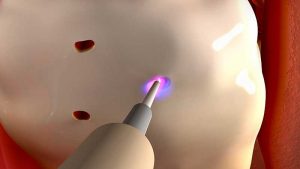Polycystic ovary syndrome, known as PCOS, is the most common disorder, involving hormones, affecting women. It includes a variety of health issues and causes a multitude of symptoms.
What is Polycystic Ovary Syndrome?
Polycystic ovary syndrome, or PCOS, is a hormonal endocrine disorder affecting women, in which estrogen and progesterone levels are not in balance. The imbalances of PCOS can cause the growth of ovarian cysts, and enlarged ovaries, however, not every woman with PCOS will have an ovarian cyst. However, in some cases, the ovaries may have abnormal growth, and when it is excessive, it enlarges and blocks the production of eggs from the ovaries leading to infertility. It can also take a toll on other areas of the body including the thyroid, adrenal function, insulin levels and the pancreas.
While PCOS is a general term for this condition, it is multifaceted and there are a few different types of PCOS that women may experience that determine the symptoms and severity of their condition.
Click Here for a look at the Types of PCOS
How is PCOS Diagnosed?
Women of childbearing age are typically the most diagnosed for PCOS as they tend to find out when they have problems getting pregnant and they schedule to see their doctor, however, PCOS affects approximately 12 percent of women in the United States, and it can occur at any age.
Diagnosis of the disorder is multifaceted. Due to its slew of symptoms that can mimic other conditions, more often than it should happen, a PCOS case is misdiagnosed.
Click here for more about The Complexity of Delayed or Missed PCOS Diagnosis
Typical diagnosis occurs only when women begin noticing symptoms or fail to get pregnant. During a diagnosis, a doctor will perform a variety of tests and exams to rule out other conditions. These exams typically include a pelvic exam, which is performed to detect any masses or abnormalities in the reproductive organs. A transvaginal ultrasound (an internal ultrasound conducted using a wand-like device (transducer) inside the vagina), which is used to examine the ovaries and the uterus for unusual appearances such as the presence of cysts. In addition, blood tests can be used to measure hormone levels and exclude other possible conditions.
Once diagnosis is complete, women with PCOS may be scheduled for periodic checks of blood pressure, glucose tolerance, cholesterol and triglyceride levels, hormone levels and even obstructive sleep or depression screenings.
What are the Signs and Symptoms?

PCOS causes hormone imbalances, specifically a rise in male hormones. These hormones can produce increased facial and body hair, acne, excessive sweating, and hair loss, skin rashes and mood swings, weight gain, bloating, and poor gut health.
Additional hormonal production that is influenced with PCOS is LH/FSH ratios, androgens which build up and are responsible for many of the symptoms, insulin, and progesterone which decreases and contributes to irregular periods.
And while the word polycystic may seem obvious for a symptom, not all women with PCOS have cysts.
PCOS has a high risk of occurrence with other conditions such as;
- Type two diabetes
- Hypertension
- High cholesterol
- Cardiovascular disease
- Metabolic syndrome
- Liver inflammation
- Sleep apnea
- Depression and Bipolar disorder
- Infertility
- Mental health issues
- Uterine bleeding
- Endometrial cancer
- Gestational diabetes or preeclampsia
What Causes PCOS?
Although the precise causes of PCOS are unknown, certain factors may contribute to its development including insulin resistance, hormone abnormalities with production, inflammation, genetics or even autoimmune disorders.
When it comes to insulin resistance, this contributes to the pancreas producing more insulin in the body. This excess insulin can increase male hormone production, which may hinder ovulation. Women with polycystic ovary syndrome are resistant to the effect of insulin, which implies that more insulin is released to keep the glucose levels under control. The high levels of insulin then stimulates the ovaries to produce more testosterone. These elevated levels of both insulin and testosterone disrupt ovulation, characterized by period abnormalities and low fertility.
With PCOS, there is also insulin-related weight gain. It’s important to note that although weight gain is not an underlying cause of polycystic ovary syndrome, obesity is a risk factor for insulin resistance. The effect of which is a further spike in insulin levels.
Luteinizing hormone produced from the pituitary gland works alongside insulin in promoting testosterone production. Studies indicate that about four women have elevated levels of luteinizing hormone in every ten women with PCOS.
Women with higher incidences of inflammation throughout the body can develop symptoms of PCOS. The inflammation may cause the ovaries to produce more male hormones. Genetics may also play a role in developing PCOS, as women with female relatives suffering from PCOS have higher rates of the syndrome themselves. Recent studies are also pointing to autoimmunity as a potential factor of PCOS.
The causes of PCOS are not limited to these factors however, and ongoing research continues to seek out exact causes and additional knowledge about the onset of this disorder.
The Impact on Fertility
In simple terms, PCOS alters menstrual cycles and hormone production, preventing ovulation, or the release of an egg. Without ovulation, women will be unable to become pregnant.
Although ovulation issues are common in those with PCOS, there are many options available to help women become pregnant such as hormone therapy, prescription medications, herbal remedies such as inositol and spearmint, dietary lifestyle changes, and with assisted reproductive treatments. It is because of the complexity and correlation with fertility that early diagnosis and treatments are key to helping women in successful conception and pregnancy.
What Treatments Are Available?

A number of medications may be prescribed or suggested by your doctor, Metformin is one such medication commonly used. Although this medication is often used to lower insulin levels in patients with type two diabetes, it may also help to promote regular ovulation and regular menstruation. In patients that are prediabetic, it can slow the progression to full type two diabetes.
For women trying to become pregnant, medications may be necessary to help ovulation. Clomiphene is another medication which is taken orally during the first phases of the menstrual cycle. Metformin is then often used in conjunction with clomiphene to increase the effectiveness.
Follicle-stimulating hormone (FSH) and luteinizing hormone (LH) therapy approaches are hormone replacement therapies that can be used when clomiphene and metformin fail. Injectable medications such as Letrozole may later be prescribed if these other medications do not work.
For those looking to avoid medicated assistance with managing PCOS symptoms and becoming pregnant, key lifestyle changes can be made to help conceive.
One of the best natural approaches to improve your chances of becoming pregnant and overcoming PCOS symptoms is with a PCOS-friendly diet. Because of the link between PCOS and diabetes, a proper diet and the maintaining of a healthy body weight can aid in avoiding bigger problems down the road. Since inflammation and high blood glucose levels are two threatening factors with PCOS, foods on the high glycemic index, dairy, bad fats, sugar and artificial sweeteners, processed foods, and soy should be avoided. These foods cause a spike in blood sugar and can affect the amount of insulin released into the blood stream.
A low carbohydrate diet, with a focus on complex-carbs, can help to lower insulin levels. These carbohydrates are high in fiber content and take the body longer to digest, thus leading to a slower increase in blood sugar levels. Planning out meals with whole foods, lots of fresh produce and an increase in fiber can help guide a PCOS-friendly diet. In addition to a healthy diet, frequent exercise and proper supplementation may help further increase fertility levels to help with conception, or serve as an alternative to prescription medication.
Click here for A 7-Day Sample PCOS Meal Plan

Surgery is another treatment option available to help with conception. In women with PCOS, the outer shells of the ovaries are often thickened, thus hindering normal ovulation. Ovarian drilling is one approach which can be successful in promoting ovulation, but only works for a short time. For a laparoscopic ovarian drilling approach, the doctor makes small holes in the surface of the ovaries. This procedure results in a significant decrease in male hormones.
PCOS is a common disorder affecting women, but there are a number of treatment options available and still in the works and lifestyle changes available for women to select to help increase fertility and overcome hindering symptoms.
Women exhibiting possible signs of PCOS should contact their primary care doctor to discuss diagnosis and treatment options.




